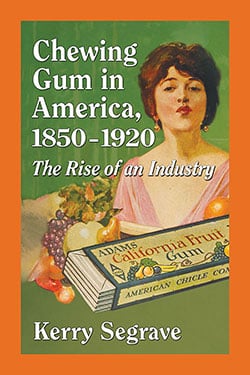Subtotal: $23.99
Chewing Gum in America, 1850–1920
The Rise of an Industry
Original price was: $39.95.$19.99Current price is: $19.99.
In stock
About the Book
Americans began chewing gum long before 1850, scraping resin from spruce trees, removing any bits of bark or insects and chewing the finished product. Commercially-made gum was of limited availability and came in three types—tree resin, pretroleum-based paraffin and chicle-based—the latter, a natural latex, ultimately eclipsing its rivals by 1920. Once considered a women-only bad habit, chewing gum grew in popularity and was soon indulged in by all segments of society. The gum industry tried vigorously to export the habit, but it proved uniquely American and would not stick abroad.
This book examines the chewing gum industry in the United States from 1850 to 1920, the rise and spread of gum chewing and the reactions—nearly all negative—to the habit from editorial writers, reformers, religious figures, employers and the courts. The age-old problem of what to do with chewed gum—some saved it in lockets around their neck; some shared it with friends—is also covered.
About the Author(s)
Bibliographic Details
Kerry Segrave
Format: softcover (6 x 9)
Pages: 224
Bibliographic Info: 33 photos, notes, bibliography, index
Copyright Date: 2015
pISBN: 978-0-7864-9845-1
eISBN: 978-1-4766-1981-1
Imprint: McFarland
Table of Contents
Table of Contents
Preface 1
Introduction 3
1. The Business of Gum 5
2. Women and Children 50
3. Popularity and Pervasiveness 64
4. Usage, Geography and Consumers 78
5. Editorials, Commentaries, Reformers and Religion 97
6. Physical and Mental Effects 121
7. Employment and the Courts 146
8. Gum Goes Abroad … but Does Not Stick 155
9. Wads, Novelties and Numbers 173
Chapter Notes 195
Bibliography 205
Index 213
Book Reviews & Awards
“Highly recommended”—Choice; “an extraordinary contribution to cultural history collections, extensively researched yet accessible to readers of all backgrounds…enthusiastically recommended”—Midwest Book Review.

 Culture Wars in British Literature
Culture Wars in British Literature 




